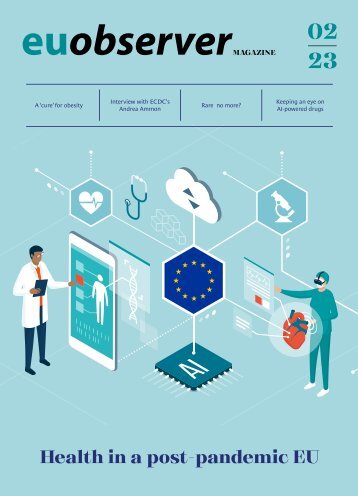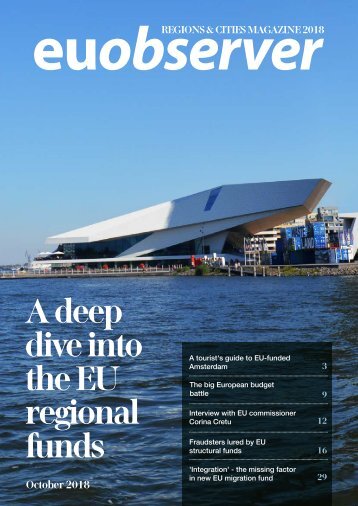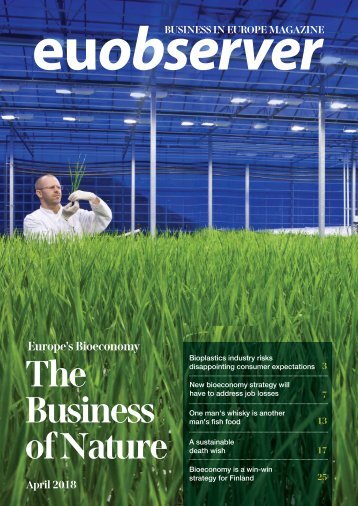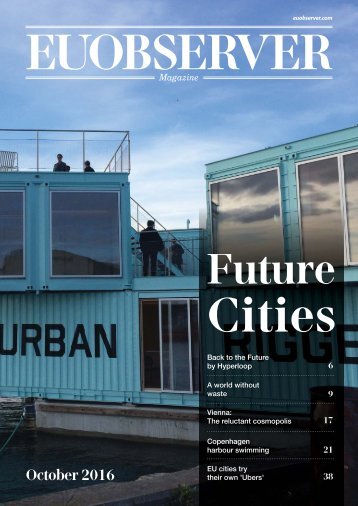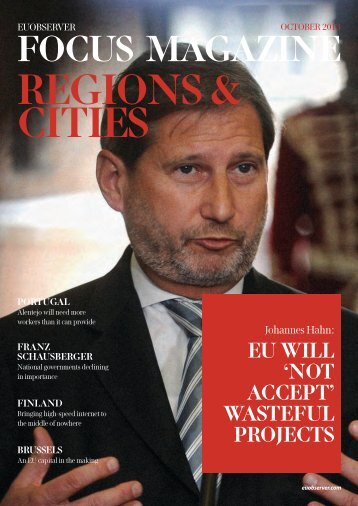Regions & Cities 2013: Cohesion Policy and Regional Aid
- Text
- Enlargement
- Finland
- Regions
- Portugal
- Artic
- Hahn
- Aid
- Policy
- Regions
- Cities
- Brussels
Beja INTERNATIONAL
Beja INTERNATIONAL AIRpORT - two FLIGHTS pER wEEk From the outside, Beja international airport looks clean and snazzy. Inside, the six check-in desks, car rental services and tourist information office are all ready to serve you. By: Benjamin Fox F rom the outside, Beja international airport looks clean and snazzy. Inside, the six check-in desks, car rental services and tourist information office are all ready to serve you. However, there is one problem. For the moment, few people fly there. The runway, an impressive 3.4 kilometres long, stands empty most of the time. Since the airport was opened in 2011, after over a year of delay, just over 5,000 passengers on fewer than 200 flights have passed through the arrival gates. Airport director Pedro Neves told EUobserver that 90 flights are expected to come in and out of Beja in 2013 - equivalent to just under two per week. Despite this lack of activity, as part of its operating license the airport has to be prepared to receive any kind of plane at three hours’ notice. It still employs 17 staff on the site. The site, which was previously used as a military airbase, was converted at a cost of €33 million, co-financed by the Portuguese government and the EU. It is not clear whether the economic crisis has been a contributing factor in the airport’s failure to secure regular flights from a single carrier. Budget airline Ryanair had been touted as a possible customer, but chose instead to focus on increasing its Portuguese services to Faro in the Algarve, already a popular tourist destination. For the sake of comparison, last year Lisbon airport saw more than 15 million passengers come through its doors, while Faro and Oporto saw 5.6 million and 6 million travellers, respectively. If Neves is disappointed by the airport’s apparent failure to attract tourists, he is not showing it. He says he expects “significant numbers of passengers” to use the airport by 2017-2018. Meanwhile, with the airport unlikely to get revenue from passenger flights any time soon, it has shifted its attention to transporting cargo and providing long-term parking facilities for aircraft. Neves says that the €11 million cost of a new aircraft hangar, needed to enable the airport to fly cargo, is to be financed exclusively by aircraft maintenance firm Aeromec. However, this too has been delayed. Construction of the hangar was originally expected to start in autumn 2012, only for the project, which is expected to create around 150 jobs, to be postponed because of funding delays. Work is not expected to begin before 2014. An agreement has also been signed with Portuguese airline TAP to provide a maintenance and parking service for planes. Local officials, including Beja’s mayor, Jorge Pulido Valente, do not see the airport as a failure, claiming that the cargo facilities will make it easier to transport the region’s rich array of agricultural produce. It also forms part of a transport hub, they say, complementing the region’s recently built highways and the port at nearby Sines, 50km away. But while visiting the deserted airport is a surreal experience, it is difficult to assess whether it has been a victim of Portugal’s economic troubles or is simply a ‘white elephant’ project that should never have been built. That companies are prepared to invest in developing the site suggests that its longterm business model is viable. For the moment, however, it offers a runway to nowhere. 18 OCTOBER 2013 REGIONS & CITIES
The Regional Research and Innovation strategy of Puglia Region, launched in 2009, objectives each pursuing several mostly funded by the ERDF Operational Programme Puglia 2007-2013: Promoting the need for innovation of Apulian enterprises Strengthening the regional research system and its potential connections with the production system Identifying new type of partnerships between science and industry to satisfy collective needs Promoting innovative and technological oriented start-ups Spreading ICT technologies and experimenting new approaches to innovation Initiative funded under the ERDF Puglia 2007-2013 – Axis VIII – 8.2 Puglia 2007/2013 – Asse VIII – 8.2 OCTOBER 2013 REGIONS & CITIES 19
- Page 1 and 2: EUOBSERVER OCTOBER 2013 FOCUS MAGAZ
- Page 3 and 4: OCTOBER 2013 REGIONS & CITIES 3 Eur
- Page 5 and 6: A s Anne-Mari Leppinen tells it, he
- Page 7 and 8: Assembly of European Regions Youth
- Page 9 and 10: OCTOBER 2013 REGIONS & CITIES 9
- Page 11 and 12: Some general facts about theRepubli
- Page 13 and 14: ARCTIC REGION TO SEE GREATER FOCUS
- Page 15 and 16: But urban planners are working - al
- Page 17: EU COHESION pOLICy: ‘No MORE BUSI
Inappropriate
Loading...
Mail this publication
Loading...
Embed
Loading...
